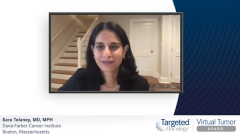
Case 3: Triple-Positive Metastatic Breast Cancer
Episodes in this series

Ruta Rao, MD: We’ll move on to our third case, which is a case of triple-positive metastatic breast cancer. This patient is a 49-year-old premenopausal woman of Middle East descent who is diagnosed with a grade 3 invasive ductal carcinoma. It’s ER [estrogen receptor] positive, PR [progesterone receptor] positive, and HER2 [human epidermal growth factor receptor 2] positive. Her BRCA1, BRCA2 mutation testing shows that she’s wild type. She is treated initially with neoadjuvant TCHP [taxane, carboplatin, trastuzumab, pertuzumab] and has a good clinical response but some residual disease. She’s a residual T2N0. She’s treated with adjuvant radiation therapy as well as adjuvant T-DM1 [trastuzumab emtansine]. Let’s ask Dr Sadimin to comment on this subtype of patient with triple-positive disease or ER-positive, PR-positive, and HER2-positive disease.
Evita Sadimin, MD: We look at the different subtypes of breast cancer based on their hormone receptor status and the HER2 expression, and we divide them into 4 subgroups: luminal A, luminal B, HER2 expressers, and triple negative. In this case, with ER positive/PR positive and HER2 positive, it would be categorized as luminal B, which accounts for about 10% to 12% of the patient population. A majority of patients have luminal A–type cancer, which is ER positive, PR positive with HER2 negative. The HER2 expressers are the negative hormone receptor status with a positive HER2. For the patients with triple-negative breast cancer, everything is negative.
Ruta Rao, MD: Thank you. Dr Tolaney, do you have any comments on the typical natural history or outcomes for patients with triple-positive diseases as compared with the ER-negative, PR-negative, HER2-positive patients?
Sara Tolaney, MD, MPH: We treat these patients similarly to our ER-negative patients. In fact, outcomes are fairly similar. We do see that the hormone receptor–positive, HER2-positive patients seem to have less brain metastases compared with the ER-negative, HER2-positive subgroup. From that standpoint, they tend to do a bit better. But in terms of overall survival, it’s quite similar between the 2 subsets.
Ruta Rao, MD: The NCCN [National Comprehensive Cancer Network] says for these patients to do anti-HER2 therapy along with antiestrogen therapies. Does your approach differ for patients who are ER positive, PR negative, and HER2 positive, Dr Jhaveri?
Komal Jhaveri, MD, FACP: No. As Dr Tolaney was pointing out, our management doesn’t change regardless of the hormone receptor status. Whether we’re thinking about neoadjuvant-based therapies or we’re thinking about metastatic-based therapies, we’re still following the same guideline that we’re following for treatment of HER2-positive patients. The options just increase, as you can imagine, for these patients because we can offer them antiestrogen-based therapies in addition to anti-HER2 therapies.
When we’re thinking about brain metastases, the prevalence is less with patients with ER positive, and the outcome might be slightly better there. Similarly, pCR [pathologic complete response] might be slightly lower as one would expect from ER-positive patients with HER2-negative disease as well compared with when we’re thinking about an ER-negative/HER2-positive patient, yet the disease-free survival doesn’t differ between the 2 subsets. That is why we offer the same neoadjuvant-based chemotherapy with anti-HER2 therapy approaches and residual disease patients with T-DM1 [trastuzumab emtansine]. We can offer antiestrogen therapy in the adjuvant setting, and we have data for supporting antiestrogen therapy with anti–HER2-based therapies in the metastatic setting for these patients.
Ruta Rao, MD: What would you offer this patient? Remember, she’s 49 years old and premenopausal. What would you offer her for adjuvant hormone therapy? Can you also comment on the duration of the hormone therapy you would recommend, Dr Tolaney?
Sara Tolaney, MD, MPH: Because she’s premenopausal, our choices fall between adjuvant tamoxifen and using ovarian suppression in combination with either tamoxifen or an aromatase inhibitor. The data that we have come predominantly from the SOFT study and the TEXT study when it comes to ovarian suppression. While these trials included HER2-positive patients, it was a small proportion. We’re drawing conclusions based predominantly on data that come from mostly ER-positive, HER2-negative patients, and those data suggest that ovarian suppression has benefit, particularly in patients who are under the age of 35 years old—our young patients, or patients who continue to menstruate after completion of chemotherapy, who are patients with higher-risk disease. This is something that we also think about incorporating ovarian suppression into.
With HER2-positive disease, it’s complicated because a big driver of outcomes is the HER2-directed therapy. They’re gaining a lot of risk reduction from their HER2-directed therapy. My general thoughts are to think about tamoxifen as 1 option, but for someone who has higher-risk disease, someone who had residual disease after preoperative therapy, or someone who is under the age of 35 years old, I’d consider using ovarian suppression to help improve outcomes because of the higher-risk features.
Transcript edited for clarity.














































